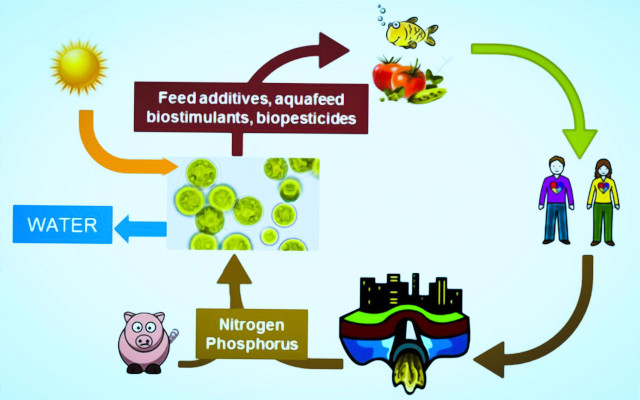The extraordinary potential of microalgae-already known for producing food and renewable energy under the banner of carbon farming (1,2,3)-also unravels in agriculture, aquaculture, wastewater upcycling and greenhouse gases.
1) Microalgae in agriculture
Soil health is critical to food production and the ecosystem services it provides (e.g., carbon absorption, water purification, pest control, biodiversity protection).
However, 60-70% of European soils are degraded, and it is therefore necessary to drastically reduce the use of synthetic pesticides, herbicides and fungicides. (4)
Microalgae can facilitate this ecological transition in agriculture as highly effective biostimulants in stimulating plant growth and increasing resistance to pathogens and various other attacks. (5,6) As was demonstrated, among other things, in the rescue of olive trees affected by Xylella Fastidiosa. (7)
1.1) SABANA, the research project in Horizon 2020.
The EU research project SABANA-in Horizon 2020, coordinated by Professor Gabriel Ancién (University of Almeria) and the biotechnology company Algaenauts – allowed us to further investigate the potential of different strains of microalgae and cyanobacteria (Anabaena, Arthrospira platensis, Chlorella vulgaris R-117, Dolichospermum, Nannochloropsis gaditana, Nostoc commune, Scenedesmus almeriensis, Scenedesmus obliquus, as well as microalgae native to Tunisia) in agriculture.
A large-scale integrated biorefinery was thus set up, to cultivate microalgae by upcycling seawater, wastewater and centrates, sewage and pig manure. Biomass is then used to produce biostimulants, biopesticides and feed additives, as well as biofertilizers and aquaculture feed. Farmers who tested microalgae products rated their higher efficiency compared with corresponding synthetic agrochemicals.
2) Microalgae in aquaculture
Necton S.A. has been producing microalgae in Faro, Portugal, for more than 25 years. Its founder João Navalho reports to Euronews that microalgae play ‘a very important role in what could be the future in Europe‘ for less environmentally harmful human and animal food. (8) Researchers from IPMA(Instituto Português do Mar e da Atmosfera), at the Olhão Aquaculture Research Station, are in turn studying the use of various strains of microalgae in feeding adult fish.
Feeding farmed fish with microalgae, in addition to responding to their natural diet, allows them to:
- Save the use of wheat-based feeds. Thus reducing the consumption of agricultural land for feed production,
- ‘improve animal welfare by strengthening their immune systems and resistance to stress‘ compared with feeding fish oils and fishmeal (Sara Castanho, researcher, IPMA). (8)
3) Upcycling of wastewater and greenhouse gases.
A recent study from Nanchang University in China (P. Xu et al., 2023) demonstrates the extraordinary ability of microalgae to simultaneously absorb CO2 and produce useful biomass for various applications. Microalgae can fix carbon 10-50 times more than terrestrial plants, and most of them can absorb various elements including CO2, carbonate and bicarbonate.
The ability of microalgae to absorb large amounts of carbon and nitrogen also allows them to be used to remove exhaust gases that contain these elements. Studies show that the cultivation of microalgae in a system where renewable energy and wastewater are used enables the production of biomass with very low or even negative carbon emissions. (9)
4) Biopolymers from microalgae. The Nenu2PHAr research project.
Nenu2PHAr
is the European research project that is perfecting the production of natural polymers from marine bacteria and sugars extracted from microalgae. The production of bioplastics is essential to lowering greenhouse gas emissions in the production of plastics from fossil fuels. (10) Although the very patterns of plastic consumption, reuse and recycling need to be reformed, to mitigateocean pollution and ubiquitous microplasticpollution. (11)
The sustainability of bioplastics from microalgae-as of any of their applications starting with food, itself tested in the EU research project ProFuture (12)-is also linked to the fact that the production of the raw materials does not require the use of arable land. And the properties of the resulting bioplastics-assures Pierre Lemechko, biotechnology researcher at IRMA(Institut Régional des Matériaux Avancés, France)-are comparable to traditional plastics. (8)
Dario Dongo and Alessandra Mei
Cover image from SAVANA EU research project, overall concept
Notes
(1) Dario Dongo. ProFuture, microalgae to feed the planet. The EU research project. GIFT (Great Italian Food Trade). 18.6.19
(2) Dario Dongo, Andrea Adelmo Della Penna. Algae and microalgae for food use in Europe, the ABC. GIFT (Great Italian Food Trade). 14.11.22
(3) Dario Dongo, Giulia Pietrollini. Algae and microalgae. Carbon farming and CO2 upcycling. GIFT (Great Italian Food Trade). 18.1.23
(4) Dario Dongo. Soil protection, strategy 2030. THE ABC’S. GIFT Great Italian Food Trade). 6.12.21
(5) BK. González-Pérez, A.M. Rivas-Castillo, A. Valdez-Calderón, M.A. Gayosso-Morales. Microalgae as biostimulants: a new approach in agriculture. 26.11.2021, doi: 10.1007/s11274-021-03192-2. PubMed. https://pubmed.ncbi.nlm.nih.gov/34825262/
(6) Dario Dongo, Andrea Adelmo Della Penna. Animal husbandry, algae and microalgae to prevent antibiotic use. Algatan. GIFT (Great Italian Food Trade). 9.9.20
(7) Dario Dongo, Andrea Adelmo Della Penna. Biostimulants in olive growing, organic revolution. Scientific Review. GIFT (Great Italian Food Trade). 14.5.21
(8) Denis Loctier. Researchers in Europe turn to microscopic algae for answers to our environmental problems. https://www.euronews.com/green/2023/01/31/researchers-in-europe-turn-to-microscopic-algae-for-answers-to-our-environmental-problems Euronews. 3.2.23
(9) P. Xu, J. Li, J. Qian, B. Wang, J. Liu, R. Xu, P. Chen, W. Zhou. (2023). Recent advances in CO2 fixation by microalgae and its potential contribution to carbon neutrality. ScienceDirect, doi: 10.1016/j.chemosphere.2023.137987, https://www.sciencedirect.com/science/article/abs/pii/S0045653523002540#preview-section-abstract
(10) Dario Dongo, Alessandra Mei. Plastics and greenhouse gas emissions, an emergency to be prevented. Scientific study. GIFT (Great Italian Food Trade). 9.2.20
(11) Marta Strinati, Dario Dongo. Microplastics even in our lungs. The British study. GIFT (Great Italian Food Trade). 12.4.22
(12) Dario Dongo. ProFuture, microalgae to feed the planet. The EU research project. GIFT (Great Italian Food Trade). 18.6.19





